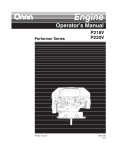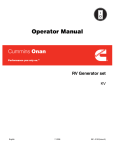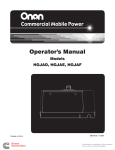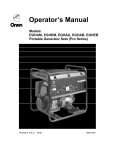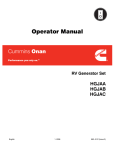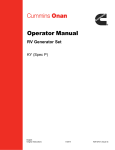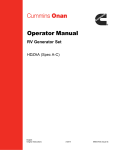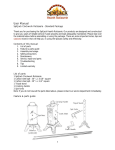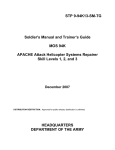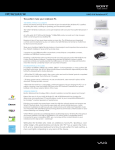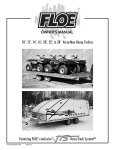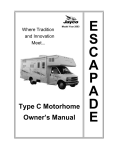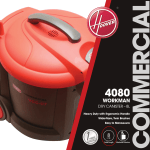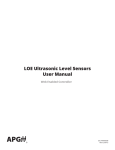Download P248V Performer Series
Transcript
P248V Performer Series Printed in U. S. A 965-0183 " " The engine exhaust from this product contains chemicals known to the State of California to cause cancer, birth defects or other reproductive harm. Redistribution or publication of this document, by any means, is strictly prohibited. Table of Contents SAFETY PRECAUTIONS . . . . . . . . . . . . . . . . . . . . . . . . . . . . . . . . . . . . . . . . . . . . . . . . . . . . 2 INTRODUCTION . . . . . . . . . . . . . . . . . . . . . . . . . . . . . . . . . . . . . . . . . . . . . . . . . . . . . . . . . . . . 4 About this Manual . . . . . . . . . . . . . . . . . . . . . . . . . . . . . . . . . . . . . . . . . . . . . . . . . . . . . 4 Model Identification . . . . . . . . . . . . . . . . . . . . . . . . . . . . . . . . . . . . . . . . . . . . . . . . . . . . 4 Exhaust—Non-Floorcare Engines . . . . . . . . . . . . . . . . . . . . . . . . . . . . . . . . . . . . . . . 4 Exhaust—Floorcare Engines . . . . . . . . . . . . . . . . . . . . . . . . . . . . . . . . . . . . . . . . . . . 6 Fuel Recommendations . . . . . . . . . . . . . . . . . . . . . . . . . . . . . . . . . . . . . . . . . . . . . . . . 7 Engine Oil Recommendations . . . . . . . . . . . . . . . . . . . . . . . . . . . . . . . . . . . . . . . . . . 7 Starting Batteries . . . . . . . . . . . . . . . . . . . . . . . . . . . . . . . . . . . . . . . . . . . . . . . . . . . . . . 7 OPERATION . . . . . . . . . . . . . . . . . . . . . . . . . . . . . . . . . . . . . . . . . . . . . . . . . . . . . . . . . . . . . . . . 8 Pre-start Checks . . . . . . . . . . . . . . . . . . . . . . . . . . . . . . . . . . . . . . . . . . . . . . . . . . . . . . 8 Starting . . . . . . . . . . . . . . . . . . . . . . . . . . . . . . . . . . . . . . . . . . . . . . . . . . . . . . . . . . . . . . 8 Stopping . . . . . . . . . . . . . . . . . . . . . . . . . . . . . . . . . . . . . . . . . . . . . . . . . . . . . . . . . . . . . 9 Engine Break-In . . . . . . . . . . . . . . . . . . . . . . . . . . . . . . . . . . . . . . . . . . . . . . . . . . . . . . . 9 Operation in Dusty Conditions . . . . . . . . . . . . . . . . . . . . . . . . . . . . . . . . . . . . . . . . . . 9 Operation in Hot Weather . . . . . . . . . . . . . . . . . . . . . . . . . . . . . . . . . . . . . . . . . . . . . . 9 Operation in Cold Weather . . . . . . . . . . . . . . . . . . . . . . . . . . . . . . . . . . . . . . . . . . . . . 9 Out-of-Service Protection . . . . . . . . . . . . . . . . . . . . . . . . . . . . . . . . . . . . . . . . . . . . . 10 Returning the Engine to Service . . . . . . . . . . . . . . . . . . . . . . . . . . . . . . . . . . . . . . . . 10 PERIODIC MAINTENANCE . . . . . . . . . . . . . . . . . . . . . . . . . . . . . . . . . . . . . . . . . . . . . . . . . . 11 Daily (8 Hour) Maintenance . . . . . . . . . . . . . . . . . . . . . . . . . . . . . . . . . . . . . . . . . . . . 12 Engine Oil and Filter Change . . . . . . . . . . . . . . . . . . . . . . . . . . . . . . . . . . . . . . . . . . 12 Air Cleaner Maintenance . . . . . . . . . . . . . . . . . . . . . . . . . . . . . . . . . . . . . . . . . . . . . . 14 Cooling System Maintenance . . . . . . . . . . . . . . . . . . . . . . . . . . . . . . . . . . . . . . . . . . 15 Spark Plug Replacement . . . . . . . . . . . . . . . . . . . . . . . . . . . . . . . . . . . . . . . . . . . . . . 15 Gasoline Fuel Filter Replacement . . . . . . . . . . . . . . . . . . . . . . . . . . . . . . . . . . . . . . 16 Spark Arrestor Cleaning . . . . . . . . . . . . . . . . . . . . . . . . . . . . . . . . . . . . . . . . . . . . . . . 16 ADJUSTMENTS . . . . . . . . . . . . . . . . . . . . . . . . . . . . . . . . . . . . . . . . . . . . . . . . . . . . . . . . . . . 17 Carburetor Adjustments . . . . . . . . . . . . . . . . . . . . . . . . . . . . . . . . . . . . . . . . . . . . . . . 17 Choke Cable Adjustment (Gasoline Engines) . . . . . . . . . . . . . . . . . . . . . . . . . . . . 17 Engine Speed Adjustment . . . . . . . . . . . . . . . . . . . . . . . . . . . . . . . . . . . . . . . . . . . . . 18 TROUBLESHOOTING . . . . . . . . . . . . . . . . . . . . . . . . . . . . . . . . . . . . . . . . . . . . . . . . . . . . . . 19 SPECIFICATIONS . . . . . . . . . . . . . . . . . . . . . . . . . . . . . . . . . . . . . . . . . . . . . . . . . . . . . . . . . . 20 INFORMATION FOR CALIFORNIA ENGINE USERS . . . . . . . . . . . . . . . . . . . . . . . . . . . 21 Redistribution or publication of this document, by any means, is strictly prohibited. 1 Safety Precautions • Benzene and lead in some gasolines have been identified by some state and federal agencies as causing cancer or reproductive toxicity. Do not to ingest, inhale or contact gasoline or its vapors. Thoroughly read the OPERATOR’S MANUAL before operating the engine. Safe operation and top performance can be obtained only with proper operation and maintenance. The following symbols in this Manual alert you to potential hazards to the operator, service person and equipment. • Do not work on the engine when mentally or physically fatigued or after consuming alcohol or drugs. alerts you to an immediate hazard which will result in severe personal injury or death. • Carefully follow all applicable local, state and federal codes. WARNING This engine is not designed or intended for use in aircraft. Such use can lead to engine failure, severe personal injury or death. WARNING alerts you to a hazard or unsafe practice which can result in severe personal injury or death. alerts you to a hazard or unsafe practice which can result in personal injury or equipment damage. CAUTION FUEL IS FLAMMABLE AND EXPLOSIVE • Keep flames, cigarettes, sparks, pilot lights, electrical arc-producing equipment and switches and all other sources of ignition well away from areas where fuel fumes are present and areas sharing ventilation. Electricity, fuel, exhaust, moving parts and batteries present hazards which can result in severe personal injury or death. GENERAL PRECAUTIONS • Do not fill the fuel tank while the engine is running. • Keep ABC fire extinguishers handy. • Fuel lines must be copper or steel tubing or piping, adequately secured and free of leaks. • Make sure all fasteners are secure and torqued properly. • Use approved flexible fuel hose for connections at the engine. Do not use copper tubing as a flexible connector—vibration will cause it to work-harden and break. Use non-conductive hose if the fuel line could become a path for cranking current. • Keep the engine and its compartment clean. Excess oil and oily rags can catch fire. Dirt and gear stowed in the compartment can restrict cooling air. • Before working on the engine, disconnect the negative (–) battery cable at the battery to prevent starting. • LPG leaks into an inadequately ventilated • Use caution when making adjustments while the engine is running—hot, moving or electrically live parts can cause severe personal injury or death. space can lead to explosive accumulations of gas. LPG sinks when released into the air and can accumulate inside basements and other below-grade spaces. Precautions must be taken to prevent gas leaks and the accumulation of gaseous fuel in the event of a leak. • Used engine oil has been identified by some state and federal agencies as causing cancer or reproductive toxicity. Do not ingest, inhale, or contact used oil or its vapors. • The fuel line must have a manual shutoff valve unless the highest fuel level in the supply tank is lower than the connection at the engine. Redistribution or publication of this document, by any means, is strictly prohibited. 2 ENGINE EXHAUST IS DEADLY! BATTERY GAS IS EXPLOSIVE • Wear safety glasses and do not smoke while servicing batteries. • Learn the symptoms of carbon monoxide poisoning in this Manual. • When disconnecting or reconnecting battery cables, always disconnect the negative (–) battery cable first and reconnect it last to reduce arcing. • Inspect the exhaust system every time the engine is started and after every eight hours of operation. If the exhaust noise changes, shut down the engine immediately and have it inspected. MOVING PARTS CAN CAUSE SEVERE PERSONAL INJURY OR DEATH • The integral exhaust system must not be modified in any way. • Do not wear loose clothing or jewelry near moving parts such as PTO shafts, fans, belts and pulleys. • Do not use engine cooling air to heat a room. • Keep hands away from moving parts. • Make sure there is ample fresh air when operating the engine in a confined area. • Keep guards in place over fans, belts, pulleys, etc. e-floorcare Redistribution or publication of this document, by any means, is strictly prohibited. 3 Introduction ABOUT THIS MANUAL This manual covers the operation and maintenance of the vertical-shaft Performer Series of engines. Each operator of the power equipment should study this engine manual carefully and observe all of its instructions and precautions. Proper use and periodic maintenance are responsibilities of the operator(s) and are essential for top performance. P248V–L/11610H L981234567 MODEL IDENTIFICATION Whenever contacting an Onan dealer or distributor for information, parts or service, always provide the model number and the serial number marked on the nameplate of the engine. Figures 1 and 2 illustrate typical engine nameplates. Figure 3 illustrates a typical engine and the location of the nameplate. SN5782U1L2AA 782 cc LPG FUEL ONLY FIGURE 1. TYPICAL NAMEPLATE—LPG Genuine Onan replacement parts obtained from an Onan dealer or distributor are recommended. WARNING Improper service or replacement of parts can result in severe personal injury or death. Service personnel must be qualified to perform electrical and mechanical service. EXHAUST—NON-FLOORCARE ENGINES P248V–I/11264F EXHAUST GAS IS DEADLY! The equipment operator is responsible for checking for exhaust leaks on a daily basis and for having the leaks repaired before operating the equipment. L981234567 Mobile Equipment Do not operate engine-powered mobile equipment inside buildings or other enclosed spaces unless there is ample fresh air ventilation. SN5782U1G2RA Stationary Equipment 782 cc UNLEADED GASOLINE ONLY The exhaust system of a stationary engine-powered piece of equipment installed inside a building or other enclosed space must be leak free and carry all exhaust gases to the outside, well away from windows, doors, vents and other openings. FIGURE 2. TYPICAL NAMEPLATE—GASOLINE Redistribution or publication of this document, by any means, is strictly prohibited. 4 LPG CUTOFF SOLENOID ELECTRIC STARTER LPG CONVERTER (REGULATOR) THROTTLE CABLE CLAMP AUTO SHUTDOWN CONTROL UNIT SPARK ARRESTOR BATTERY CHARGING REGULATOR AIR PRECLEANER NAMEPLATE LOCATION AIR FILTER HOUSING OXYGEN SENSOR (BACK OF MUFFLER) CATALYTIC MUFFLER CRANKSHAFT FIGURE 3. TYPICAL CONFIGURATION SHOWING A FLOORCARE ENGINE Redistribution or publication of this document, by any means, is strictly prohibited. 5 EXHAUST—FLOORCARE ENGINES WARNING If the emissions warning light comes on and the engine shuts down, emissions of deadly carbon monoxide gas could be excessive. Do not restart the engine. See Troubleshooting. An LPG engine for floorcare equipment has an exhaust emissions control system consisting of a catalytic muffler, oxygen sensor, auto shutdown control unit, LPG fuel cutoff solenoid, LPG converter (regulator) and LPG carburetor (Figure 3). The emissions warning light on the control unit (Figure 4) will come on if the control unit senses that the exhaust emission levels (O2) are out of specification. Approximately one minute after the light comes on, the control unit will shut down the engine. Proper operation and maintenance requires that you: • Run the equipment only in well ventilated areas. Refer to Industrial Ventilation—A Manual of Recommended Practice published by the American Conference of Governmental Industrial Hygienists. The user is responsible for complying with indoor carbon monoxide regulations. FIGURE 4. EMISSIONS WARNING LIGHT • Attach a CO monitor to the equipment. • Keep air cleaners clean. Do not apply oil. • Do not run the engine if there is an exhaust leak. A leak can cause gases to bypass the catalytic element or change the calibration of the auto shutdown system allowing excessive emissions of CO. A leaky exhaust system can result in higher levels of deadly carbon monoxide gas emissions. Do not operate the equipment if there is an exhaust leak. WARNING • Do not tip the engine to either side. Tipping the engine can allow oil to enter the air cleaner and cause the engine to run rich and shut down. • Do not modify or disable any engine function or system. • Keep to the maintenance schedule. Redistribution or publication of this document, by any means, is strictly prohibited. 6 FUEL RECOMMENDATIONS ENGINE OIL RECOMMENDATIONS Gasoline and LPG are highly flammable fuels and can cause severe personal injury or death. Do not smoke if you smell gas or gasoline or are near fuel tanks or fuel-burning equipment or are in an area sharing ventilation with such equipment. Keep flames, sparks, pilot lights, electrical arcs and arc-producing equipment and all other sources of ignition well away. Use premium quality motor oil. Look for the API (American Petroleum Institute) classification and use Class SG or SH oil (also SG/CD, SG/CE, SH/ CD or SH/CE). Also look for the SAE (Society of Automotive Engineers) viscosity grade. Referring to Table 1, choose the viscosity grade appropriate for the ambient temperatures expected during the period of time until the next scheduled oil change. WARNING Single-grade SAE 30 oil is preferable when temperatures are consistently above freezing. Multigrade oils are better when wide temperature variations are expected. Gasoline Engines Use clean, fresh unleaded gasoline having a minimum octane rating (Anti-Knock Index) of 87. TABLE 1. OIL VISCOSITY VS. TEMPERATURE During some times of the year only mandated “oxygenated” gasolines may be available. These are acceptable for use, but not preferable. Leaded gasoline may be used but will result in the extra maintenance required for removing combustion chamber and spark plug deposits. Do not use gasoline or gasoline additives (de-icers) containing methanol because methanol can be corrosive to fuel system components. Do not use gasoline or gasoline additives containing methanol because methanol can be corrosive to fuel system components. EXPECTED AMBIENT TEMPERATURES SAE VISCOSITY GRADE 32° F (0° C) and higher 30 10° F to 100° F (–12° C to 38° C) 15W-40 (OnaMax) 0° F to 80° F (–18° C to 27° C) 10W-30 10W-40 –20° F to 50° F (–28° C to 10° C) 5W-30 CAUTION STARTING BATTERIES Avoid using highly leaded gasolines and lead additives because of the extra engine maintenance that will be required. The engine is equipped with a 12 volt electric starter. Prompt starting requires sufficient battery capacity and battery cable size. Neither cranking performance nor starter service life will be satisfactory with an undersized battery. LPG Engines Use clean, fresh HD-5 grade liquified petroleum gas or equivalent product consisting of at least 90 percent propane. Commercial liquified petroleum gas fuels may contain more than 2.5 percent butane which can result in poor fuel vaporization and poor engine starting in low ambient temperatures. Regular, monthly maintenance of batteries may be required. See Periodic Maintenance and any instructions available from the equipment or battery manufacturer. It should be noted that as long as the equipment is operated regularly, the automatic battery recharging system on the engine should be able to maintain battery charge. See OUT-OF-SERVICE PROTECTION under Operation regarding battery care during storage for prolonged periods. Note: LPG must be supplied from a vapor-withdrawal fitting on the LPG container, at container pressure and connected to the engine fuel cut-off solenoid/regulator assembly by a hose approximately 30 inches (76 cm) long. Redistribution or publication of this document, by any means, is strictly prohibited. 7 Operation WARNING STARTING EXHAUST GAS IS DEADLY! 1. Check the oil level if this is the first start of the day and add oil as necessary. Exhaust gases contain carbon monoxide, an odorless, colorless gas. Carbon monoxide is poisonous and can cause unconsciousness and death. Symptoms of carbon monoxide poisoning include: • Dizziness • Nausea • Vomiting CAUTION Starting without oil will cause severe engine damage. Keep the oil level between the Full and Add marks. 2. Fill up with fuel if necessary and open any fuel shutoff valve. (Connect only to the vaporwithdrawal fitting on an LPG container.) • Headache • Weakness and Sleepiness • Inability to Think Clearly 3. Disengage the clutch if so equipped. IF YOU OR ANYONE ELSE EXPERIENCE ANY OF THESE SYMPTOMS, GET OUT INTO FRESH AIR IMMEDIATELY. If symptoms persist, seek medical attention. Shut down the engine and do not operate it until it has been inspected and repaired. 4. Pull the choke knob out to its full-choke position. (An LPG engine does not have a choke.) Note: Try starting without the choke in warm weather or when the engine is warm. 5. If the equipment has a throttle knob or lever, push it to the middle of its speed range. Make certain the exhaust system is properly installed. Inspect it every time the engine is started and after every eight hours of operation. 6. Turn the ignition-start switch to its start position and hold it there until the engine starts. Do not crank for more than 30 seconds at a time. Wait at least one minute between crankings. See Troubleshooting if the engine does not start after several tries. PRE-START CHECKS CAUTION Never tip the engine on either side. Engine oil can enter the air cleaner and cause the engine to run rich and shut down. 7. Gasoline Engine: As the engine starts keep your hand on the choke knob, slowly pushing it to wide open, but pulling back as necessary to keep the engine running smoothly. The colder the weather the longer it will take. Do not operate the equipment until the engine runs smoothly with the choke wide open. Before the first start of the day and after every eight hours of operation perform the maintenance specified under Periodic Maintenance. Check for exhaust and fuel system leaks every time you start the equipment. Keep a log of maintenance and hours run and perform any maintenance that may be due. If the equipment has been in storage see RETURNING THE ENGINE TO SERVICE. Floor Care Engine: Operate the equipment as intended. The emissions warning light on the electronic control unit should go off in about 30 seconds after the engine starts. If the light comes on and the engine shuts down, do not restart the engine. See Troubleshooting. WARNING Moving parts can cause severe personal injury or death. Hot exhaust parts can cause severe burns. Stay clear and make sure all guards and shields are secure before starting up the equipment. Observe all of the equipment manufacturer’s operating instructions and safety precautions. WARNING If the emissions warning light comes on and the engine shuts down, emissions of deadly carbon monoxide gas could be excessive. Do not restart the engine. See Troubleshooting. Redistribution or publication of this document, by any means, is strictly prohibited. 8 STOPPING OPERATION IN HOT WEATHER Turn the ignition-start switch to OFF and close the LPG tank shutoff valve. If this is a gasoline engine and the fuel tank is higher than the engine, close the manual shutoff valve in the supply line. Pay particular attention to the following items when operating the engine in temperatures above 100° F (38° C): 1. Keep the engine cooling fins and flywheel air inlet screen and precleaner (floorcare) clean. See to it that nothing obstructs air flow to and from the engine. ENGINE BREAK-IN Engine break-in as a result of proper care during the first hours of operation of a new or rebuilt engine results in the ideal fitting of all internal moving metal parts, which is essential for top engine performance. For controlled engine break-in: 2. Check the oil level more frequently. 3. Change the oil and oil filter more often than normal. See Table 2. 1. Operate the equipment as it is intended to be operated. However, for the first 3 hours, if possible, operate the equipment at about half the available engine power, occasionally operating at full engine power for brief periods. Also, if possible, avoid prolonged low-speed, low-power operation during engine break-in. 4. Make sure the engine oil viscosity is appropriate for the ambient temperatures and change the oil if necessary. See Table 1. OPERATION IN COLD WEATHER Note: Floorcare engines are designed for indoor use only, at normal ambient temperatures. 2. Proper engine oil (p. 7) is especially critical during break-in because of the higher engine temperatures that can be expected. Change the oil if it is not appropriate for the ambient temperatures during the break-in period (Table 1). Pay particular attention to the following items when operating the engine in temperatures below freezing: 1. Make sure the engine oil viscosity is appropriate for the ambient temperatures and change the oil if necessary (Table 1). If the temperature drops before you have the chance to change the oil, warm up the engine by moving the equipment into a heated space before attempting to start the engine or change oil. 3. Check the oil level twice a day or after every 4 hours of operation during the first 25 hours of operation. 4. Change the oil and oil filter after the first 25 hours of operation. WARNING EXHAUST GAS IS DEADLY! Never operate mobile engine-powered equipment indoors without ample fresh air ventilation. 5. On a floorcare engine, have the valve clearance readjusted after the first 25 hours of operation. 2. Use fresh fuel and fill the fuel tank after each day’s use to reduce problems with moisture condensation. OPERATION IN DUSTY CONDITIONS 1. Keep the engine cooling fins and flywheel air inlet screen and precleaner (floorcare) clean. 3. Keep the battery in a well-charged condition. 2. Perform air cleaner maintenance more often than normal—as required. See Table 2. 4. After each use push the equipment throttle knob or lever (if so equipped) to the middle of its speed range so that if ice forms on the linkage during storage it will be easier to start the engine. 3. Change the engine oil and oil filter more often than normal. See Table 2. Redistribution or publication of this document, by any means, is strictly prohibited. 9 the burning oil on startup could cause the engine to shut down. OUT-OF-SERVICE PROTECTION CAUTION Never tip the engine on either side. Engine oil can enter the air filter and cause the engine to run rich and shut down. 4. Perform air cleaner and precleaner (floorcare) maintenance as instructed in Periodic Maintenance. Protect an engine that will be out of service for more than 30 days as follows: CAUTION Do not oil the foam wrapper on a floorcare engine. Oil can cause the engine to run rich and shut down. 1. Run the engine until it reaches normal operating temperature, shut off the fuel supply and let the engine run until it stops. 5. Clean the governor linkage and wrap it with a clean cloth for protection. Gasoline preservatives (stabilizers) are toxic. Follow the instructions on the container label. Avoid skin contact. Wash your hands with soap and water after dispensing the fluid. WARNING 6. Plug the exhaust outlet to prevent moisture, dirt, bugs, etc. from entering. 7. Provide a suitable cover for the entire unit. 8. If so equipped, disconnect the battery (negative [–] cable first) and follow the battery or equipment manufacturer’s storage instructions. Gasoline Engine: If the equipment will not be operated for more than 120 days, add a fuel preservative (OnaFreshTM) to the gasoline fuel tank. Follow the instructions on the container label. Unless a preservative (stabilizer) is added, the gasoline will deteriorate causing fuel system corrosion, gum formation and varnish-like deposits which can lead to hard starting and rough operation. RETURNING THE ENGINE TO SERVICE 1. Remove the cover and all protective wrapping and the plug from the exhaust outlet. 2. Check the tag on the oil base. Change the oil if the viscosity is not appropriate for the expected ambient temperatures (Table 1). LPG leaks inside a garage or other inadequately ventilated space or near a pit or basement or other belowgrade space can lead to explosive accumulations of gas because LPG “sinks” when it is released into the air. Check for and comply with all local ordinances regarding the storage of LPG containers. WARNING 3. Check the fuel filter (gasoline engines) and fuel lines to make sure they are secure and have no cracks or leaks. 4. Check to see that the choke, throttle and governor linkages move freely. LPG Engine: Store the LPG container as required by local ordinance. 5. If so equipped, clean and check the battery according to the battery or equipment manufacturer’s instructions and connect the battery cables (positive [+] cable first). 2. Drain the oil from the engine while it is still warm. Refill with fresh oil and attach a tag stating the viscosity of the oil used. 6. Start the engine. The initial startup may be slow and there may be smoke and rough operation for a few minutes until the oil in the cylinder burns off. If the engine does not start, clean or replace the spark plugs as they may have been fouled by the oil added to the cylinder when the equipment was stored. 3. On a gasoline engine only, remove the spark plugs and squirt 2 tablespoons (28 grams) of rust inhibitor or SAE 30 oil into each cylinder. Crank the engine over a few times and reinstall the spark plugs. Do not do this on a floorcare engine. The emissions caused by OnaFresh is a trademark of the Onan Corporation Redistribution or publication of this document, by any means, is strictly prohibited. 10 Periodic Maintenance Periodic maintenance is essential for top engine performance. Use Table 2 as a guide for normal periodic maintenance. Under hot or dusty operating conditions some maintenance operations should be performed more frequently, as indicated by the footnotes in the table. Keep a log of maintenance performed and the hours run. Recording maintenance will help you keep it regular and provide a basis for supporting warranty claims. Maintenance, replacement or repair of emission control devices and systems may be performed by any engine repair establishment or individual. However, warranty work must be completed by an authorized Onan dealer or distributor. Never tip the engine on either side. Engine oil can enter the air cleaner and cause the engine to run rich and shut down. CAUTION TABLE 2. PERIODIC ENGINE MAINTENANCE SCHEDULE MAINTENANCE FREQUENCY MAINTENANCE OPERATION First 25 Hours7 Daily, Every Every Every Every Every Every Every 50 100 200 500 1000 8 Month Hours Hours Hours Hours Hours Hours ALL ENGINES Inspect Engine x1 Check Oil Level x Clean Air Cleaner Foam Wrapper x2 Clean Cylinder Cooling Fins x2 x4 Check Starting Battery Change Engine Oil x Change Engine Oil Filter x x2, 3 x2, 3 x2 Replace Air Cleaner Element & Foam Wrapper Replace Spark Plugs x FLOORCARE ENGINES ONLY Clean Air Precleaner x Replace LPG Filter x5 Clean Spark Arrestor x Adjust Valve Clearance x5 x Replace Oxygen Sensor x5 Replace Catalytic Muffler x5 GASOLINE ENGINES ONLY Replace Fuel Filter x x5 Adjust Valve Clearance x5, 6 Clean Cylinder Heads 1. 2. 3. 4. 5. 6. Check for oil, fuel and exhaust leaks, loose parts and unusual noises and vibrations. Perform more often when operating in dusty conditions. Perform more often when operating in hot conditions. See instructions for battery care provided by the equipment or battery manufacturer. Must be performed by a qualified mechanic according to the engine Service Manual. Clean more often when running the engine continuously under light load. Use a carburetor and combustion chamber cleaner every 200 hours of operation. 7. Perform as part of engine break-in. Redistribution or publication of this document, by any means, is strictly prohibited. 11 fill tube. Wipe the dip stick clean and push it back into the oil fill tube until the cap seats and withdraw it to check the oil level. Add oil of recommended type (p. 7) if the level is below the ADD mark. Drain oil if the level is above the FULL mark. Secure the fill cap. DAILY (8 HOUR) MAINTENANCE Check the following before the first start of the day and after every eight hours of operation: 1. Inspect fuel lines and fittings for leaks. Repair leaks immediately. CAUTION Too much oil can cause high oil consumption, high operating temperatures and oil foaming. Too little oil can cause severe engine damage. Keep the oil level between the Full and Add marks on the dipstick. A leaky exhaust system can result in higher levels of deadly carbon monoxide gas emissions. Do not operate the equipment if there is an exhaust leak. WARNING 2. Look and listen for exhaust system leaks while the engine is running. Look for cracks and severe rusting in the muffler and tailpipe. Have all leaks repaired before continuing to operate the equipment. ENGINE OIL AND FILTER CHANGE State and federal agencies have determined that contact with used engine oil can cause cancer or reproductive toxicity. Take care to limit skin contact and breathing of vapors as much as possible. Use rubber gloves and wash exposed skin. WARNING A clogged air precleaner or flywheel inlet screen can cause the engine to overheat or run rich and shut down. Do not operate floor cleaning equipment without the air precleaner in place. Keep the cooling fins and air inlet screen clean and wash a precleaner regularly as prescribed. CAUTION Refer to Table 2 for scheduled oil change and filter replacement and see Figure 5. 1. Run the engine until it is warm. Stop the engine and disconnect the spark plugs and, if so equipped, the battery negative (–) cable. 3. Check the engine for dirt and debris and clean the flywheel air inlet screen and cylinder cooling fins as necessary. On floorcare equipment engines, remove the cooling air precleaner element daily (every 8 hours) and wash it in warm water and mild detergent. Rinse it thoroughly and let it dry before reusing it. Do not oil. WARNING Accidental starting of the engine can result in severe personal injury or death. Always disconnect the spark plugs and the battery negative (–) cable before changing oil. 2. Remove the oil fill cap. Crankcase pressure can blow hot engine oil out the fill tube causing severe burns. Always stop the engine before removing the oil fill cap. WARNING Crankcase pressure can blow hot engine oil out the fill opening causing severe burns. Always stop the genset before removing the oil fill cap. WARNING 4. Check the engine oil level. First park the equipment on a level surface, stop the engine and wait a minute or so to allow the oil to settle in the crankcase. Then turn the oil fill cap (Figure 5) counterclockwise and lift it from the 3. Place a pan under the oil drain opening and remove the oil drain plug or open the drain valve. Reinstall the plug or close the valve securely after the oil has drained completely. Redistribution or publication of this document, by any means, is strictly prohibited. 12 4. Spin off the oil filter canister making sure the gasket comes off with it. Dispose of the used oil and oil filter in accordance with local environmental regulations. OIL FILL CAP AND DIPSTICK 5. Thoroughly wipe off the filter mounting surface on the engine, make sure the gasket is in place on the new filter canister, apply a thin film of oil to the gasket and spin on the new filter cannister. Tighten it 1/2 to 3/4 turn past the point where the gasket just touches the block. Do not overtighten. 6. Refill with the recommended oil (p. 7). Check the oil level and add more oil if below the ADD mark or drain oil if above the FULL mark. See Specifications for the oil capacity. Secure the fill cap. Too much oil can cause high oil consumption, high operating temperatures and oil foaming. Too little oil can cause severe engine damage. Keep the oil level between the Full and Add marks on the dipstick. CAUTION OIL DRAIN VALVE OR PLUG 7. Reconnect the spark plugs and battery and start and run the engine for a short time while checking for oil leaks around the drain plug and oil filter. Tighten only as necessary to eliminate leaks. OIL FILTER FIGURE 5. OIL FILL CAP AND DIP STICK, FILTER AND DRAIN Redistribution or publication of this document, by any means, is strictly prohibited. 13 gine oil. Knead the oil into the wrapper and wring out the excess. Too heavy a coat will restrict air flow and cause loss of engine power. To install, stretch the foam wrapper over the paper air cleaner element, not leaving any exposed paper pleats. AIR CLEANER MAINTENANCE Refer to Table 2 for scheduled foam wrapper maintenance and air cleaner element replacement. See Figure 6. Foam Wrapper Maintenance Air Cleaner Element Replacement Do not remove the inner air cleaner cover when cleaning or replacing the foam wrapper only. Wash the foam wrapper in water and detergent, squeeze it dry like a sponge, rinse with clean water and let it dry. Replace a foam wrapper that is torn or stretched. To keep anything from entering the carburetor and engine while the air cleaner element is off, place a piece of duct tape over the opening, or close the choke if so equipped. Remove the outer cover and wipe away loose dust and debris from the air cleaner assembly. Remove the inner air cleaner mounting nut and cover. Remove the air filter paper element and foam wrapper from the engine. Wipe off dust and debris from the air cleaner base. CAUTION Do not oil the foam wrapper on a floorcare engine. Oil can cause the engine to run rich and shut down. Floorcare Engines: To install, stretch the foam wrapper over the paper air cleaner element, not leaving any exposed paper pleats. Do not oil. Remove any duct tape over the opening and install the new paper element and secure it with the inner cover and mounting nut. Reinstall the foam wrapper and outer cover. Make sure to reconnect the the crankcase breather tube. Non-Floorcare Engines: Coat the wrapper evenly with one tablespoon (14 grams) of SAE 30 en- OUTER NUT OUTER COVER AIR CLEANER ELEMENT PULL CRANKCASE BREATHER TUBE OUT WHEN REMOVING INNER COVER AIR CLEANER ASSEMBLY BASE INNER NUT INNER COVER FOAM WRAPPER FIGURE 6. AIR CLEANER ASSEMBLY Redistribution or publication of this document, by any means, is strictly prohibited. 14 COOLING SYSTEM MAINTENANCE Refer to Table 2 for scheduled cleaning of the cylinder cooling fins. On floorcare equipment engines, remove the cooling air precleaner element every 4 to 8 hours of operation and wash it in warm water and mild detergent. Rinse it thoroughly and let it dry before reusing it. Do not oil the element. A clogged air precleaner or flywheel inlet screen can cause the engine to overheat or run rich and shut down. Do not operate floor cleaning equipment without the air precleaner in place. Keep the cooling fins and air inlet screen clean and wash a precleaner regularly as prescribed. CAUTION COOLING FINS Use compressed air to clean the cylinder cooling fins. Take the following precautions. FIGURE 7. CYLINDER COOLING FINS 1. Wear safety glasses. WARNING Always wear safety glasses when using compressed air to prevent severe eye damage. 2. Let the engine cool. The temperature stresses caused by cleaning a hot engine can crack the cylinder. 3. Make sure the air cleaner element is in place to keep dirt out of the engine. SPARK PLUG REPLACEMENT Refer to Table 2 for scheduled spark plug replacement and Specifications for gap specifications. To prevent crossthreading the spark plug always thread it in by hand until it seats. Then turn it with a wrench an additional 1/16 turn (22-1/2°). If you have a torque wrench, tighten the spark plugs to 11 lbs-ft (14 N-m). SPARK PLUGS FIGURE 8. SPARK PLUGS Redistribution or publication of this document, by any means, is strictly prohibited. 15 GASOLINE FUEL FILTER REPLACEMENT Refer to Table 2 for scheduled fuel filter replacement and Figure 3 for the location of the fuel filter (if so equipped). Also refer to the equipment Operator’s Manual regarding any supplemental fuel filters that may have been provided and the recommended frequency for their replacement. Take care not to spill fuel when disconnecting the fuel line from the filter. Allow the engine to cool before disconnecting the fuel line so that it cannot ignite any fuel that may be spilled. Close any shutoff valve that may be provided in the fuel line. If the filter is of the in-line type, it is usually removable by loosening the inlet and outlet hose clamps. FUEL FILTER WARNING Gasoline is highly flammable and can cause severe personal injury or death. FIGURE 9. GASOLINE FUEL FILTER Let the engine cool and close any fuel line shutoff valve before disconnecting the fuel line from the filter. Do not smoke if you smell gasoline or are near fuel tanks or gasoline-burning equipment or are in an area sharing ventilation with such equipment. Keep flames, sparks, pilot lights, electrical arcs and arc-producing equipment and all other sources of ignition well away. SPARK ARRESTOR CLEANING Refer to Table 2 for scheduled spark arrestor cleaning (floorcare engines). To clean the spark arrestor, remove the retaining screw and pull it from the muffler. Use a wire brush or compressed air to clean the spark arrestor. SPARK ARRESTOR WARNING Always wear safety glasses when using compressed air to prevent severe eye damage. FIGURE 10. SPARK ARRESTOR Redistribution or publication of this document, by any means, is strictly prohibited. 16 Adjustments CARBURETOR ADJUSTMENTS REAR-PULL CHOKE CABLE These engines have precision-manufactured carburetors which are not adjustable. CHOKE LEVER (open position) CHOKE CABLE ADJUSTMENT (GASOLINE ENGINES) Referring to Figure 11, reconnect and reclamp the choke cable as follows: 1. Stop the engine and disconnect the spark plugs and, if so equipped, the battery (negative [–] cable). CLOSE CHOKE WARNING Accidental starting of the engine can result in severe personal injury or death. Always disconnect the spark plug and battery (negative [–] cable) before resetting the engine control cables. CABLE CLAMP 2. Push the equipment choke knob to the fullopen choke position. FRONT-PULL CHOKE CABLE 3. Connect the choke cable to the choke lever. (The cable will either hook into the choke lever or be clamped by a screw in a swivel on the choke lever. See Figure 11.) Pull the slack out of the cable and clamp it. INTERMEDIATE LINK AND LEVER CHOKE LEVER (open position) 4. Check for smooth movement and full travel of the equipment choke knob. Remove the air cleaner element as explained under Periodic Maintenance to see that the choke plate opens and closes fully. CLOSE CHOKE 5. Reassemble the air cleaner and reconnect the spark plug and battery. SWIVEL CLAMP CABLE CLAMP FIGURE 11. CHOKE CABLE Redistribution or publication of this document, by any means, is strictly prohibited. 17 ENGINE SPEED ADJUSTMENT HIGH-IDLE SPEED STOP TANG Do not bend the high-idle speed stop tang unless you are a qualified mechanic and have an accurate tachometer to set the high-idle speed in accordance with the equipment manufacturer’s specifications Normally only the equipment manufacturer will need to make initial engine speed adjustments, which must be attempted only by a qualified mechanic using proper tools and meters. ENGINE THROTTLE LINK WARNING Moving parts can cause severe personal injury or death. Take care, use the proper tools and meters and follow the manufacturer’s instructions for the tools and meters. You must be a qualified mechanic. In the absence of specifications, it is recommended that low-idle speed be adjusted to 1100 RPM and high-idle speed to 3400 RPM. Adjust floorcare equipment to a low-idle speed of 1500 RPM and a high-idle speed of 2800 RPM. WARNING Adjusting equipment to run at greater than specified speeds may cause operation in violation of Federal and State Standards for Safety for the equipment. THROTTLE CABLE (Pull cable sheath to remove slack before clamping) CABLE CLAMP LOW-IDLE SPEED STOP SCREW Referring to Figure 12, adjust speed as follows: 1. Start the engine, observing all of the equipment manufacturer’s instructions and precautions. 2. If the throttle cable has already been connected, loosen the clamp at the engine and back out the low-idle speed stop screw so that the speed stop screw on the carburetor touches its stop. Adjust engine speed to 1000 RPM (1400 RPM for floorcare ) with the carburetor speed stop screw. 3. Turn the low-idle speed stop screw to obtain the specified low-idle speed. CARBURETOR SPEED STOP SCREW 4. Move the engine throttle link up against its stop tang and hold it there while bending the tang as necessary to obtain the specified high-idle speed. FIGURE 12. SPEED ADJUSTMENTS 5. Hook the engine throttle link with the throttle cable, pull the slack out of the throttle cable and tighten the clamp. Check for full, smooth movement of the engine throttle link between its two stop positions when the equipment throttle lever is moved through its full range. Redistribution or publication of this document, by any means, is strictly prohibited. 18 Troubleshooting corrective actions suggested, contact an equipment dealer or Onan dealer. Many troubleshooting procedures present hazards that can result in severe personal injury or death. Only qualified service personnel with knowledge of fuels, electricity, and machinery hazards should perform service procedures. Review Safety Precautions. WARNING Floorcare Engines: If the emissions warning light comes on and the engine shuts down, service the air precleaner, air cleaner and spark arrestor. Have the engine serviced if that does not restore operation. Table 3 provides basic troubleshooting guidance. If you fail to resolve the problem after taking the TABLE 3. TROUBLESHOOTING Corrective Action Problem 1. The engine fails to crank. 2. The engine slowly. cranks 3. The engine cranks but fails to start. 4. The engine runs and then stops. 5. The engine exhausts black smoke. 6. The engine misfires. a. Release the clutch (if so equipped). b. Clean and tighten the positive (+) and negative (–) battery cable connections at the battery and the engine. c. Recharge the battery. Refer to the equipment or battery manufacturer’s recommendations. a. Release the clutch (if so equipped). b. Clean and tighten the positive (+) and negative (–) battery cable connections at the battery and the engine. c. Recharge the battery. Refer to the equipment or battery manufacturer’s recommendations. d. Change engine oil to oil having the proper viscosity for the ambient temperature. See Table 1. a. Check the fuel tank or LPG container and fill as necessary. b. Check, and if necessary, reconnect the fuel line to the vapor-withdrawal fitting on the LPG container. c. Open any closed fuel shut off valve. d. Check engine oil level and add oil as necessary. e. Reconnect the spark plug cables if loose. f. Readjust the choke cable (gasoline engines). See Adjustments. g. Service the air cleaner. h. Replace the gasoline fuel filter (if provided). i. Clean the air precleaner (floorcare engines). j. Replace the spark plugs. a. Check the fuel tank or LPG container and fill as necessary. On cold days an LPG container may have to be warmed up inside to attain the rate of vaporization necessary to keep up with engine demand. b. Check, and if necessary, reconnect the fuel line to the vapor-withdrawal fitting on the LPG container. c. Check the engine oil level and add oil as necessary. Drain excess oil if the level is above the dipstick Full mark. d. Readjust the choke cable (gasoline engines). See Adjustments. a. Service the air cleaner. b. Readjust the choke cable (gasoline engines). See Adjustments. a. Replace the spark plugs. Redistribution or publication of this document, by any means, is strictly prohibited. 19 Specifications Engine Type Horizontally Opposed 2-Cylinder, 4-Stroke Cycle, Spark-Ignited, Side-Valve, Air-Cooled, Vertical-Shaft Bore 3.250 inches (83 mm) Stroke 2.875 inches (73 mm) 48 inches3 (782 cc) Displacement Compression Ratio 7.0 : 1 Oil Capacity (with filter)* 2 quarts (1.9 l) Intake Valve Clearance (cold) 0.005 inches (0.13 mm) Exhaust Valve Clearance (cold) 0.013 inches (0.33 mm) Spark Plug Gap 0.025 inches (0.64 mm) Spark Plug Tightening Torque 11 lbs-ft (14 N-m) Ignition Timing (non-adjustable electronic ignition) 20° BTDC LPG Fuel Supply (at the inlet to the engine gas pressure regulator) Vapor Withdrawal at LPG Container Pressure (20-200 psi [138-1380 kPa]) * –See Periodic Maintenance for oil filling instructions. Redistribution or publication of this document, by any means, is strictly prohibited. 20 Information for California Engine Users You should carefully review Operator (Owner), Installation and other manuals and information you receive with your engine or equipment. If you are unsure that the installation, use, maintenance or service of your engine or equipment is authorized, you should seek assistance from an approved Onan engine dealer or an approved dealer for your equipment. These engines meet the requirements of California’s Exhaust Emissions Standards for 1995 and later for Utility and Lawn and Garden Equipment Engines. As a California user of these engines, please be aware that unauthorized modifications or replacement of fuel, exhaust, air intake, or speed control system components that affect engine emissions are prohibited. Unauthorized modification, removal or replacement of the engine label is prohibited. California engine users may use Table 4 as an aid in locating information related to the California Air Resources Board requirements for emissions control. TABLE 4. EMISSIONS CONTROL INFORMATION Engine Warranty Information The California emissions control warranty statement is located in the same packet of information as this manual when the engine is shipped from the factory. Engine Valve Lash See Specifications. Engine Ignition Timing See Specifications. Engine Fuel Requirements Gasoline engines are certified to operate on unleaded gasoline. LPG floorcare engines are certified to operate on LPG vapor. See Fuel Recommendations in Introduction. Engine Lubricating Oil Requirements See Engine Oil Recommendations in Introduction. Engine Fuel Mixture Settings These engines have precision-manufactured carburetors which are not adjustable. Engine Adjustments See Adjustments. Engine Emission Control System The engine emissions control system consists of internal engine modifications on gasoline engines and a catalytic muffler on LPG floorcare engines. Redistribution or publication of this document, by any means, is strictly prohibited. 21 Cummins Power Generation 1400 73rd Avenue N.E. Minneapolis, MN 55432 763-574-5000 Fax: 763-528–7229 Cummins and Onan are registered trademarks of Cummins Inc. Redistribution or publication of this document, by any means, is strictly prohibited.
























